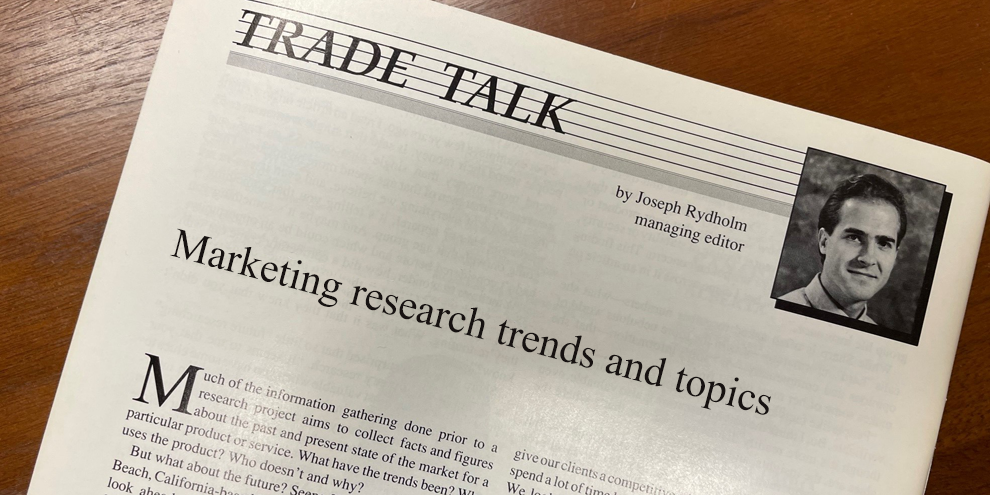Depending on the product or service, a researcher can tell you who buys it, what they buy, where they buy it and why. But not as much attention is paid to when the product is bought. A new book "The Seasons of Business" gives convincing evidence for considering the "when" part of the who/what/when/where/why equation.
Author Judith Waldrop, research editor of American Demographics magazine, and freelance writer Marcia Mogelonsky have fashioned a book that reads like a monthly journal of the nation's consumers. It begins in August (because that's the start of the busy back-to-school season, which leads into the important holiday shopping months) and moves through the rest of the year.
The book gives a compact but thorough look at consumption habits using a mix of weather data, insights from business people, countless surveys, and government stats, pre-sented in a folksy manner that's part census report and part Farmer's Almanac.
Plenty of numbers
As usual with the books I've reviewed here from American Demographics Press, "The Seasons of Business" feels thoroughly researched. It has plenty of numbers and plenty of sources. You'll also find it quite entertaining, if, like me, you find the consumer psyche fascinating.
The book uses the months and their respective holidays and weather patterns as a framework to discuss how various marketing issues are affected by the time of year. Each chapter contains mini reports on specific consumer segments such as business travelers, college students, baseball fans, Bible buyers, allergy sufferers, and newlyweds. The January chapter includes the Super Bowl; March: spring break; June: high school graduations; December: charitable activities, etc.
Winter blahs
As an example, the book shows that the month of February might be good one for TV advertisers, publishers, pizza delivery people, and makers of flu remedies. During February many people get a case of the winter blahs - that feeling of ennui that creeps over you when you realize that winter's dreary days are barely half over. It's too cold to do anything outside so people tend to stay at home. As a result, they watch a lot of TV, read books and magazines, order pizzas. They also get the flu, which sends them to the doctor or to the local pharmacy.
Now, none of this comes as a real surprise. If, for example, you work in the marketing research department of a company that makes flu remedies, you know when flu season hits and when itpeaks. So "The Seasons of Business" may nottell you anything new about the users of your particular product or service. But it may get you thinking about the various forces - such as jobs, leisure activities, family responsibilities, even the weather - that influence your target consumers throughout the year. That, in turn, may give you a different perspective that sparks an idea or a new way of approaching an old problem or question.
Think carefully
The second book also aims to get you thinking, carefully, about the demographic numbers that bombard you every day. "Selling the Story: The Layman's Guide to Collecting and Communicating Demographic Information," is actually geared for journalists and other non-marketers who don't deal with statistics for a living but who have to make sense of demographic data. Still, it has something to offer marketers and researchers who lack a strong statistical background.
Author William Dunn, now a contributing editor of American Demographics magazine, began writing about demo-graphics in 1977 as a reporter for the Detroit News after his new editor-in-chief asked him to write on population trends. Back then, as he explains in an introductory chapter, he knew little about demographics and felt he lacked the mathematical skills to deal with the subject. But in time he became comfortable with the numbers and has made a career out of writing about and interpreting them. With "Selling The Story" he aims to help people who may be in the same position he found himself in back in 1977.
The book is organized in two parts. In the first part, Dunn offers several concise chapters on major demographic categories (e.g., income, marriage and divorce, race, health, consumer spending). In each chapter he discusses how to (and how not to) think about and work with the basic measuring sticks in each category. He also offers helpful advice on frequently misunderstood aspects of demographic information, such as race vs. ethnicity or income expressed in current vs constant dollars. The chapters also include a list of information sources and questions to consider about the trends in each category.
The second part of the book includes chapters on compiling a demographic reference library, accessing information with your computer, and presenting demographic information. In addition, Dunn gives a short course on mistakes to avoid when working with figures.
While you may be well aware of these things, there may be a co-worker or someone you present research findings to who may benefit from aprimer on how to think about the numbers. Since major decisions are often made based on demographic information, it's essential that everyone using the information is thinking about it in the same way.
"The Seasons of Business: The Marketer's Guide to Consumer Behavior" (269 pages, $27.50, paperback), is by Judith Waldrop with Marcia Mogelonsky. "Selling the Story: The Layman's Guide to Collecting and Communicating Demographic Information" (245 pages, $27.50,paperback) is by William Dunn. Both books are published by American Demographics Press. For more information call 800-828-1133 or write American Demographics Books, P.O. Box 68, Ithaca, NY 14851.
